
The Dead Texan, a seemingly one-off collaboration between Stars of the Lid’s Adam Wiltzie and visual artist Christina Vantzou, has gained a second life in 2011 with a full slate of connected titles. I’ve previously written about Sleepingdog’s With Our Heads in the Clouds and Our Hearts in the Fields, which sees Wiltzie working with Dead Texan guest vocalist Chantal Acda. More recently Kranky issued A Winged Victory for the Sullen’s self-titled debut, an inspired meeting of pianist Dustin O’Halloran and Wiltzie that features album art from Vantzou. O’Halloran’s 2011 solo album Lumiere includes Wiltzie on guitar, while Vantzou contributed visuals to his live shows and put together a mesmerizing video for “We Move Lightly.” Completing the circle, Vantzou has emerged from behind the projector with her solo debut on Kranky, No. 1, which explores semi-symphonic arrangements with the San Francisco-based Magik*Magik Orchestra.
That No. 1 explores somewhat similar terrain as The Dead Texan is both understandable and a bit of a surprise. Vantzou’s musical involvement in that album was limited to a few vocal spots and mellotron performances, with much greater emphasis placed on the accompanying DVD. But a 2007 collaborative tour between Sparklehorse and The Dead Texan encouraged her musical side (covered nicely in this interview with The Muse in Music), which resulted in the long-gestating No. 1. It would have been entirely plausible for Vantzou’s solo work to lean closer to the slow-drip pop of Chantal Acda’s more straightforward Sleepingdog tracks (or something entirely different), but if anything, No. 1 leans further away from the occasional dream-pop leanings explored on The Dead Texan into glistening, amorphous drone symphonies.
The process behind the album is enlightening. Vantzou spent three years writing and recording a demo version of No. 1 as 45-minute-long piece, which involved layering keyboard tracks, exploring her options in available synth samples, and pulling textures from voice, instruments, and records. She then brought the demo version to Minna Choi of the Magik*Magik Orchestra, who added live instrumentation and altered some arrangements. Finally, Adam Wiltzie helped mix the finished product, which merges Vantzou’s original textures with strings and horns.
This process isn’t hidden in No. 1. The layers are apparent, especially when one side of the equation overtakes the other. The synth textures of “Prelude for Juan” billow to the surface, while the affecting cello vibrato on “Super Interlude Pt. 2” cuts through the mix. More often there’s an uncertain balance between the two, with the smudged synth palettes sounding like distant echoes of the live instruments. It’s a telling difference from Stars of the Lid’s exquisitely mannered performances on And Their Refinement of the Decline and Kyle Bobby Dunn’s precisely refracted drones on Ways of Meaning; No. 1 matches their overall minimalism but not the starkness of its creation.
This difference means that No. 1 relies more on textural dynamics than most records in the Stars of the Lid universe. There are moments, especially in “Super Interlude Pt. 2” and “Your Changes Have Been Submitted,” that use dramatic chord changes to spine-tingling effect (a tried-and-true tactic in Wiltzie and McBride’s oeuvre), but more often emotion comes from hearing something emerge that you didn’t think was there, like the ghostly vocals in “Joggers.” No. 1 is an album of discovery for both composer and listener, a duality that’s often expressed but rarely rings as true or essential as it does here.
If Christina Vantzou’s solo debut and the three other Dead Texan-related records from 2011 aren’t enough to check out, Vantzou will follow up No. 1 with a remix album/DVD. I’m particularly interested to see how Vantzou the visual artist comments on Vantzou the burgeoning musician; videos for “Homemade Mountains” and “Prelude for Juan” gives an early taste of patterns overtaking colors. It will also be interesting to see if Vantzou’s future recordings maintain the same sense of discovery now that she’s more familiar with the processes, but that’s a debate for another year.
|
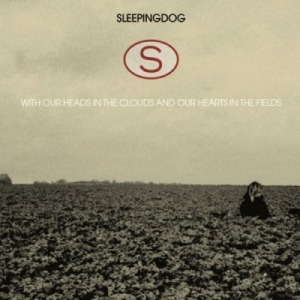
According to iTunes, I have 1556 plays of The Dead Texan’s “The Struggle” logged on my iPhone. I take this statistic with a glacier of salt; that’s 143 hours of “The Struggle,” and I don’t recall going on a six-day bender with the song. But like the other inflated play counts on my iPhone,* there’s a kernel of truth buried in that glacier. “The Struggle” is a perfect hybrid of dream pop and ambient, tailor-made to play right before I drift off to sleep. Even the lyrics, delivered in a hushed duet between Stars of the Lid’s Adam Wiltzie and guest vocalist Chantal Acda, encourage such behavior, reminding that “the sun cannot last.” A thousand plays—now that’s believable.
I’ve gotten considerable mileage out of The Dead Texan’s lone 2004 eponymous album, but I’ve had to, since Adam Wiltzie and Christina Vantzou have not reconvened for a follow-up. Sleepingdog offers a reunion of sorts, especially for those drifting off to sleep with “The Struggle.” Sleepingdog started out as the solo project for Chantal Acda, but Wiltzie became an official member after mixing the 2006 debut Naked in a Clean Bed. For 2008’s Polar Life and now 2011’s With Our Heads in the Clouds and Our Hearts in the Fields, Wiltzie has provided electronic strings and background vocals. It’s always nice to find another branch of the Stars of the Lid family tree, but this one was a particularly exciting discovery.
Does Sleepingdog live up to my unreasonably expectations for “The Struggle, Part II”? Yes and no. There are moments of somnambulist bliss, but that’s not the focus here. The Dead Texan was Wiltzie’s show—no slight intended to Vantzou, whose involvement was primarily seen on the DVD of videos for each song on the album. Likewise, Sleepingdog is Chantal Acda’s show. Her songs form the basis for any further aesthetic explorations. There are stretches of With Our Heads in the Clouds and Our Hearts in the Fields when it’s just her soft voice and minimalist piano. Eight-minute-long opener “The Untitled Ballad of You and Me” takes two minutes before Wiltzie’s presence is felt, allowing Acda’s storytelling to grab hold before chill-raising strings come in and amplify the drama of the song. For the minimal pop of “It Leaves Us Silent” and “He Loved to See the World Through His Camera”, the emphasis is on nearly naked emotion, which occasionally skews sentimental singer/songwriter over ambient-classical-informed lullabies. Reset your expectations to the mesmerizing slow-core crawl of Gregor Samsa's excellent 2008 LP Rest, and you'll approach With Our Heads in the right mindset.
There are a few songs that lean closer to The Dead Texan, specifically the instrumental “Kitten Plays the Harmony Rocket” and the near-instrumental “Horse Lullaby,” the latter of which offers a “Struggle”-esque economy of lyrics. These tracks satiate my appetite for drone classical, but those aren’t the songs I go back to. Instead, I find myself revisiting the tracks like “The Untitled Ballad of You and Me” and “Scary Movie” where Acda and Wiltzie meet halfway.
The realization that Sleepingdog’s With Our Heads in the Clouds and Our Hearts in the Fields excels when Chantal Acda and Adam Wiltzie find equal footing seems obvious in hindsight. I’ve gone back to the Dead Texan’s “The Struggle” so often because it’s a rare blend of both dream pop and ambient. When With Our Hearts splits its focus, emphasizing either Acda’s straightforward musings (with the acoustic guitar duet of "From Where It Was") or Wiltzie’s drones, it loses the power of the merger. When With Our Heads hits those passages of entrancing accord, however, it's compelling enough to keep me awake a while longer.
If you're interested in acquring a copy of Sleepingdog's With Our Hearts, you'll have to import the very limited vinyl pressing from Gizeh Records.
|
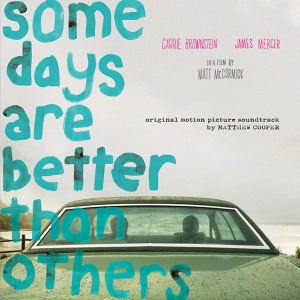
Belying his recent forays into stoner comedy, David Gordon Green started his career with a pair of oblique independent films: the childhood drama George Washington and the romance All the Real Girls. My viewings of these films had several prompts: recently catching up on Terrence Malick’s first two films (1973’s Badlands and the 1978 stunner Days of Heaven), both of which cast heavy shadows on Green’s work; former Parks and Recreation cast member Paul Schneider’s appearance in both films and co-writing credit for the latter; and the lingering suspicion that the lovely cinematography of Pineapple Express should be seen in its natural habitat. Such curiosity paid off; both films have stuck with me, particularly the inexperienced cast of child actors in George Washington and the worn-in relationship between Schneider and a young Zooey Deschanel in All the Real Girls. Tim Orr’s cinematography guides both films, most notably during a pair of lengthy montages ending their respective second acts. It’s here that Green’s visual storytelling shines brightest.
Those montages are not purely visual, as you might suspect, but they’re not the ham-fisted musical montages skewered by South Park. I immediately recognized the music of the passage in All the Real Girls as the Mogwai remix of “Mogwai Fear Satan” from Kicking a Dead Pig, but the strangely familiar ambient soundscape accompanying the passage in George Washington made me rush to IMDB for the credit. Sure enough, Stars of the Lid was somehow involved. Brian McBride’s side band The Pilot Ships contributed “Pilot Suicide Theory” from its 2000 LP The Limits of Painting and Poetry to George Washington’s soundtrack, and its backwards drones capture the range of emotions swirling around in the film. To Green’s credit, that’s no easy task.
Between “Pilot Suicide Theory” and McBride’s recent score for the documentary Vanishing of the Bees, I found myself wondering why contemporary ambient music hasn’t found its way onto more film scores. (Full disclosure: I rented The Lovely Bones because of Brian Eno’s soundtrack, but not even the use of “The Big Ship” over its closing credits could align the tonal mess which preceded it. Avoid.) Matt McCormick’s debut film Some Days Are Better Than Others had a head-start to finding its score from Eluvium’s Matthew Cooper, since it stars two notable indie rockers: Carrie Brownstein from Sleater-Kinney, Wild Flag, and the IFC sketch comedy show Portlandia, and James Mercer of The Shins and Broken Bells. The film is currently making the rounds at festivals and limited-run screenings, while Cooper’s score is now available on Temporary Residence.
Given the variety of sounds Cooper has delivered in Eluvium’s discography—the woozy drones of Lambient Material, the solo piano of An Accidental Memory in the Case of Death, the symphonic swells of Copia, the Eno-esque vocals of Similes—his score for Some Days could have gone in any number of directions. Picking up on the film’s thematic exploration of throwaway culture, Cooper opted to record the soundtrack with broken/malfunctioning keyboards, a decision which establishes the score’s aesthetic. There’s a playfulness to tracks like “Drifting” and “Worry and Care” that suggests both a church organ and a run-down carnival. Cooper manages to hit the droning palette of his early records on “Into Dust” and the tinkling, heavily backmasked “Pursuance.”
The best pieces on Some Days recall the interwoven layers of Eluvium’s finest work, 2005’s Talk Amongst the Trees. “Reprieve” carefully balances delicate details and thick blocks of keyboards. The title track starts with that curious carnival organ, but like Talk’s astounding highlight “New Animals from the Air,” keeps adding counterpoint melodies and textures. By the end of the song, the organ has disappeared and the tone has changed dramatically, but when exactly that happens is difficult to ascertain.
Cooper works best in these long pieces, since the shorter interstitials often lack depth. Not having seen the film, I can’t say if the church organ melodies of “It’s Never What It Seems” and “What You Leave Behind” are the perfect accompaniments for their respective scenes, but on record they’re gone too soon and don’t leave much of an impression. This issue made much of Cooper’s 2008 "solo album" Miniatures a fans-only concern, so perhaps he should stick to his stage name.
I hope that the film Some Days Are Better Than Others gives the song “Some Days Are Better Than Others” a fittingly evocative context. It’s the centerpiece of the soundtrack, much like “Pilot Suicide Theory” and “Mogwai Fear Satan (Mogwai Remix)” anchored George Washington and All the Real Girls respectively. It’s an excellent gateway to Matthew Cooper’s work, the best of which comes under the Eluvium banner, so if you’ve seen the film and liked what you heard, start there and then circle back to this soundtrack.
|

The first song on Kyle Bobby Dunn’s Ways of Meaning is called “Dropping Sandwiches in Chester Lake.” It might be easier to extrapolate Dunn’s aesthetic from the titles of tracks three and four—“Canyon Meadows” and “New Pures,” respectively—but the seeming nonchalance of “Dropping Sandwiches” has stuck with me. Given that Chester Lake is located in the Canadian Rockies of Dunn’s former home of Alberta, the title likely carries some anecdotal resonance that the wordless drones can’t transcribe. I’m inclined to believe that Dunn broke the stillness of the lake’s surface with the sandwiches in question, hearing the distant plunk as they slice through the surface and watching each one ripple out in concentric circles. Their trajectories intersect and then glance off one another, creating a silent network of arcs both perfect and imperfect. These arcs distort the reflection of the surrounding mountains in Spray Valley Provincial Park. All of this filters back into Dunn’s composition, a work of clock-stopping tranquility. The only thing I can’t intuit is why Dunn brought so many sandwiches with him.
To a certain extent I’m cheating with this localized discussion, since Dunn’s been in Brooklyn since 2007. But as “Chester Lake” implies, Dunn hasn’t lost his connection to Alberta. His 2009 Rural Route No. 2 EP was inspired by the childhood locales of Calgary. He’s performed in Banff National Park. These songs are open-ended enough for other mental journeys, but once I thought about Chester Lake as the destination, I kept going back to it. These ambient classical compositions make more sense aligned with regal open spaces than metropolitan clatter.
Each of Ways of Meaning’s six pieces offers a unique arrangement of those intersecting sets of concentric circles. “Canyon Meadows” stands out with the close proximity of its drones, which brush against each other like reeds in the wind. But the album’s centerpiece is the fifteen-minute-long “Movement for the Completely Fucked,” which loses all track of time as it gradually ebbs and flows with volume swells and overlapping tones. Without a watch you could mistake it for one of its five-minute-long neighbors. These specific pieces are the highlights of Ways of Meaning, but as my six full spins of the album will attest, it’s remarkably easy to get lost in this album.
I’ve filed Dunn’s geographical projections alongside Arvo Pärt’s Für Alina and Stars of the Lid’s And Their Refinement of the Decline, bridging the gap between Dunn’s minimalist composer influences and his contemporary counterparts. Pärt’s influence is apparent in the moments of near silence, especially the gradual decay that comprises the final minute of “New Pures.” Stars of the Lid is an unavoidable touchstone for ambient classical, but Dunn’s purified guitar and synth drones reside in the same aesthetic sphere. I wouldn’t mind Dunn branching out with more ensemble-based recordings like this exquisite performance from the First Presbyterian Church in Brooklyn last year, but I'm certainly not tired of his current palette. (The very end of the clip also shows Dunn’s sense of humor and is worth waiting for.)
Ways of Meaning will be out May 23 on Desire Path Recordings, with a special art version of LP on the verge of selling out. If you need to catch up—and Ways has prompted me to do just that—the 2CD A Young Person’s Guide to Kyle Bobby Dunn compiles his 2009 full-length Fervency with another hour of material.
|
Bell Gardens – Hangups Need Company CD – Failed Better, 2010 (Broadway Avenue Reckless Records, 7/15)

Reckless Records informed me of the existence of Bell Gardens by including the vinyl pressing of Hangups Need Company in their Stars of the Lid divider. Unbeknownst to me, Brian McBride—one half of Stars of the Lid—collaborated with Kenneth James Gibson from Furry Things and {a}ppendics.shuffle on this disc of '60s-style pop. McBride’s track record from Stars of the Lid and his two solo album, 2005's When the Detail Lost Its Freedom and 2010's The Effective Disconnect, is exemplary, but my hunger for Beach Boys-informed pop is limited, so consider this purchase a calculated risk.
The good news is that Bell Gardens pull off this sound more convincingly than the vast majority of their peers. It’s not a mere application of Beach Boys vocal harmonies to modern sonics and structures—“Through the Rain” could slide into an oldies playlist and no one would think twice. The bad news is that Gibson’s lyrics are often nauseating treacle. (Editor's note, courtesy of a commentator: “End of the World” is actually a cover of Skeeter Davis's 1963 song, so my dismissal of that song's on-the-nose lyrical sentiment apparently goes against a #2 Billboard hit. One that Susan Boyle covered last year. Egg on my face alert. “Breeze [Letters by the Bed]” and its “I see the sunrise in your face / I want to stay here in this place” couplet. still bug me, though.)
My favorite moments on Hangups come when things slow down enough for McBride’s compositional touches to shine through, specifically on “No Story” and “Labour at the Landmark.” They don’t sound like SOTL, mind you, but their pleasant merger of modern dream pop and vintage 60s pop lets the lyrics take a much-needed backseat.
|
Brian McBride – The Effective Disconnect: Music Composed for the Documentary “Vanishing of the Bees” LP – Kranky, 2010 – $15
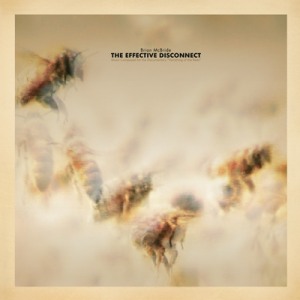
Before I get to the specifics of the second solo album from Brian McBride of Stars of the Lid (skip down to the final two paragraphs for those), I’d like to address the fundamental question that Neil Major from The Line of Best Fits asks in his review of The Effective Disconnect: “How much use are you going to get out of these exquisitely serene drones?” Focusing the utility of any album seems strange to me. I don’t purchase new music with the foremost intent of filling a specific gap in my daily routine or avoid purchasing an album because its likely application has already been filled. My biggest concern is finding good music that appeals to my sensibilities, then determining appropriate contexts for playing it. This determination isn’t always cut and dry—I’ve found Stars of the Lid’s “Tippy’s Demise” to be tremendously affecting in a commute; Marnie Stern’s new self-titled album is my current go-to dishwashing soundtrack—but I enjoy the process of hearing how different styles work in different contexts. It’s no accident that McBride’s minimal soundtrack prompts this discussion, and not an album befitting one of the other listening contexts Major prioritizes (working out, commuting, getting ready to go out). “How much you listen to it will vary more on your lifestyle that the actual quality of the music,” which suggests two things: first, there is a low-key lifestyle fit for ambient classical; second, I am living it.
The ultimate point of Major’s discussion of utility is whether someone needs more than one album of music like Stars of the Lid. (Requisite tangential anecdote: Sometime during my teenage years when my CD collection hit 50 or so, my mom suggested that I probably had enough music. Not quite, Mom.) Ten years ago I could have seen his point and very well might have agreed with him. After all, I enjoyed Windy & Carl’s Antarctica, but bristled at the thought of being a completist. Now I'm more excited about a new Brian McBride album than the majority of other recent releases, and cringe at someone saying, “You’ve got one and that’s enough,” even if that one is Stars of the Lid’s wondrous And Their Refinement of the Decline. Let me rephrase: especially if it’s And Their Refinement of the Decline.
No album changed my listening habits more in the last decade than Refinement. I’d listened to ambient music before Refinement, but never in such heavy doses or varied contexts. To wit: I made a mix CD of ambient music back in 2002 with a single intent: before Keith Fullerton Whitman’s “Modena” comes on, I’ll be asleep. Granted, Refinement is a requirement for any extended air travel for that very reason, but the other contexts have been revelatory. The broadest change: learning how Stars of the Lid works equally well in passive and active listening modes. Whether I’m reading, working, or conversing, I can have Refinement on and switch which activity maintains my foreground attention. Yet my preferred context for Stars of the Lid, et al, is decompression. Typically this means the hour before I go to bed, but it can also mean driving home from hockey. In this particular scenario, the music has my foreground attention, but is essentially pushing this attention into the background. In this case, the music created its own context.
Now here’s why one album isn’t enough: every time I listen to And Their Refinement of the Decline, it becomes harder to listen to it in a purely background context. Not only do I get more and more emotionally involved in the songs, but I notice more elements of their construction. If I made a playlist with “Tippy’s Demise” and “A Meaningful Moment During a Meaning(less) Process” and sat down to read a book, I’d barely turn the page. This phenomenon keeps accelerating with each ambient record to which I give proper time and attention. Eluvium’s Talk Amongst the Trees, The Dead Texan’s The Dead Texan, Last Days’ The Safety of the North, Tim Hecker’s Harmony in Ultraviolet, and Brian Eno’s Apollo: Atmospheres and Soundtracks (to name a few) have each gained clarity and emotion with each passing spin. The clarity extends to the space between each artist and album; much like I could go on and on about the differences between Boys Life and Castor, two Midwestern rock bands from the mid 1990s, the gap between Stars of the Lid and Eluvium keeps growing larger as well. True, it’s a fundamental experience of familiarizing one’s self with any genre, but it’s particularly exciting for such an amorphous aesthetic.
So yes, Neil Major, I do need another album of ambient classical, and Brian McBride’s The Effective Disconnect is that album. It’s an album with a very specific intended utility—the soundtrack for the documentary Vanishing of the Bees—but one which doesn’t require that context to be successful. The combination of guitar drones and classical instrumentation isn’t far off from And Their Refinement of the Decline, but specific songs distance themselves from the tonal range of Stars of the Lid. The bright chimes and buoyant optimism which begin “Beekeepers vs. Warfare Chemicals” belie the song’s title, but soon enough the dour strings take over and darken the blue skies. “Chamber Minuet” highlights its string performances, sounding more like chamber music than the blurred drones of SOTL. Yet the familiar approaches are no less evocative. “Several Tries (in an Unelevated Style)” sells itself short, since the tonal switch from higher-register strings to mournful piano is devastating. The chord swells in “Toil Theme Part 1” are equally powerful.
In Stars of the Lid and on The Effective Disconnect, Brian McBride excels at imbuing the smallest changes in chords, keys, and instrumentation with exponentially large impact. It’s too austere to become melodramatic—a criticism which does occasionally apply to stylistic kin Eluvium—and it’s simple enough not to lose effectiveness or become tiresome. Part of me is surprised that it’s taken so long for McBride and/or Stars of the Lid to helm a soundtrack, but another part recognizes the danger of using music that is so resonant on its own accord in a secondary context. Perhaps my only complaint with The Effective Disconnect is McBride’s admission that it does not contain all of the music that will be heard in the film.
|
|
How great are Amazon wish lists? I no longer have to feel guilty about having relatively esoteric tastes when it comes to gift-receiving, since the givers, in this case my in-laws (thanks!), don’t have to track down some hard-to-find LPs. There are limits to what you can find on Amazon, of course, but I enjoy hunting the out-of-print albums, so in-print albums or recent reissues make a nice foundation.
124. The Dead Texan – The Dead Texan CD+DVD – Kranky, 2004
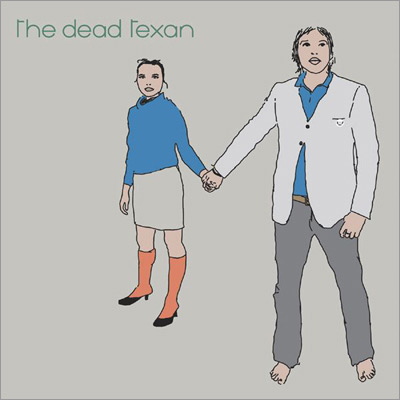
I just finished writing my entry for The Dead Texan for my decade-end album list (spoiler alert!), which means three things: first, I enjoy the album a great deal; owning it was long-overdue; and it’ll be difficult to write about the album without rehashing everything I just wrote. Instead I’ll focus on an aspect of this release that I failed to mention in that blurb: the accompanying DVD. Consisting of seven videos done by Christina Vantzos and Adam Wiltzie, the video portion is very pleasant, if not as memorable or affecting as the music, although I suspect that wasn’t the aim. The repeated motifs, casual animation, and vivid colors are more of a jumping-off point for your own imagination. If only MTV had a late-night show like 120 Minutes/Subterranean for ambient music, but that seems rather unlikely. You can watch a number of these videos on YouTube, including “Aegina Airlines,” “The Six Million Dollar Sandwich,” and personal favorite “The Struggle,” although none of them quite match up to this fan-made clip of Stars of the Lid’s “Requiem for Dying Mothers, Part 1” starring Alf.
125. Tom Waits – Swordfishtrombones LP – Island, 1983

I own three albums from earlier in Tom Waits’ career (Closing Time, Nighthawks at the Diner, and Foreign Affairs) and I’ve heard a few of his later junkyard-percussion and gravel-voiced albums (Rain Dogs and Mule Variations), but I hadn’t ventured into a commitment with any of them for a very specific reason: I know when I should listen to Tom Waits, but I’m never in that situation. Here’s the ideal situation for putting Tom Waits on my turntable: it’s 3am, I don’t know what day it is, I live in a musty apartment above a bar in run-town part of town, and I am drinking whiskey. Oh, and I’m heartbroken, but it’s been a while since the break-up, so it’s a more general sense of heartbreak. That’s the perfect storm for Tom Waits, as I imagined it, and the odds of it ever happening for me are about one in eight million. Yet Waits seems so perfect for that mood that I’ve struggled to find a replacement setting.
This morning I gave up trying to match Waits to the proper mood and put my newly acquired copy of Swordfishtrombones on the turntable. It’s 11am on a Saturday morning in December. I’m wrapping presents for my wife and watching USPS trucks swarm the neighborhood. It’s a far cry from the parade of misfits Waits invokes, but these songs still manage to set their moods. I expected a greater emphasis on the clanging, junkyard songs, but what impressed me so much about Swordfishtrombones on my first listen was the variation. The instrumentation, the production values, the moods, the vocal styles—the album switches character from song to song, yet still holds together. This feeling sunk in when “Town with No Cheer” and “In the Neighborhood” closed out side A. Those songs are closer in spirit to his earlier recordings, but the mix, the lyrics, and the delivery all separate them.
What hasn’t sunk in yet is the content of the songs. There’s no lyric sheet included with this reissue of Swordfishtrombones—I don’t know if there ever was one—and a few of Waits’ more dramatic vocal inflections prevent easy transcription of his words. The recourse for this issue may be David Smay’s 33 1/3 book on the album, which I’ve added to my to-buy list, but until then, I’ll give Swordfishtrombones a few more listens to iron out the details. I’ve long respected Tom Waits for being such a profoundly original artist, but Swordfishtrombones marks the first time that my respect wasn’t accompanied by an equal level of distance.
126. The Feelies – Crazy Rhythms LP – Bar None, 1980 [Reissue]

I’ve listened to Crazy Rhythms a few times over the years, most recently in conjunction with my post about its 1986 follow-up, The Good Earth, but it’s never fully sunk in. I understand the appeal of the record—it’s an inspired blend of post-punk, new wave, and the nascent strains of college rock—but transitioning that recognition into genuine fondness has been tricky. Here’s my theory: I’ve encountered all of their typical elements too many times outside of the context of this specific band to be surprised by them. Mid-fi production values, hyper-strummed clean guitars, casually melodic vocals that occasionally skip toward an impassioned yelp, a live-sounding drum kit; all of these elements have filtered down into later indie rock bands as building blocks of the sound, particularly in the 1980s but also (more selectively) in the 1990s and 2000s, so their combination here sounds too familiar. The Good Earth sounds more stereotypically college rock, in part because that sound officially existed by the time of its release, in part because the group’s rhythm section had changed and was less idiosyncratic. Yet that record doesn’t carry the same acclaim as Crazy Rhythms, an album I could no longer ignore now that there’s a nice vinyl reissue out.
Scott at Pretty Goes with Pretty also recently picked this album up, having noted its countless references in Dean Wareham’s Black Postcards memoir, which I’d also read late this summer. He primarily discusses the Feelies’ peers in the 1970s, namely Talking Heads and Devo, both of which make sense as points of comparison, but the key word he uses in relation to Crazy Rhythms is “hypnotic.” That’s the quality that’s stuck out to me as I keep flipping the slab of vinyl over. The rhythm section is both jittery and insistent, the fast-strummed guitars sound like 33rpm parts played at 45rpm, and Glenn Mercer’s vocals often chant lyrics fast enough to sound like an incantation. It’s a recipe for a rapidly vibrating hypnotic disk. The other point that Scott made that clicked with me is that it takes a few listens for songs to differentiate themselves from the whole, likely because of the hypnotic quality I just described. Yet after a few listens, I’m itching to hear specific songs again (“Loveless Love,” “Moscow Nights,” “Raised Eyebrows”). Perhaps Crazy Rhythms was a grower all along, but my advice would be to give it a few extra spins before passing judgment.
|
36. Prefab Sprout - Two Wheels Good - Epic, 1985
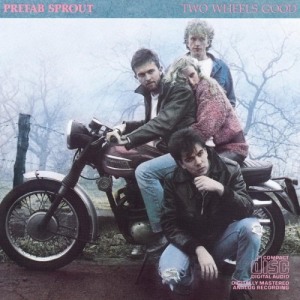
Why I Bought It: I saw Two Wheels Good (more widely known by its British name, Steve McQueen) in the dollar bin at Stereo Jack’s Records in Cambridge and vaguely recalled the band name, but I wasn’t buying enough to hit their $10 minimum purchase level for credit cards and only had enough cash to buy the soundtrack to This Is Spinal Tap and Rex’s self-titled debut. When I later learned that it’s a highly acclaimed recipient of a recent 2CD reissue, I made a mental note to venture back over there with a dollar and change in hand to pick it up. (Naturally, I ended up finding the Cocteau Twins’ Blue Bell Knoll and had to charge the purchase.)
Verdict: Due largely to Thomas Dolby’s mid-’80s production values, Two Wheels Good sounds more adult-contemporary pop than anticipated. The songs themselves, particularly closer “When the Angels,” occasionally transcend this sheen, but I found myself losing focus on what singer/songwriter Paddy McAloon is crooning about. Glancing over the lyrics on a Prefab Sprout fan site makes me want to give it another shot, but ironically—given the vinyl fetishism inherent to this project—it also makes me want to hear the acoustic bonus disc from the CD reissue.
37. Roxy Music - Stranded - ATCO, 1974

Why I Bought It: With all apologies to Stranded’s Playboy Playmate cover model Marilyn Cole, Brian Eno’s early solo work acted as my gateway to his previous band’s catalog, not Brian Ferry’s then-girlfriend. I included For Your Pleasure and Roxy Music in the last round of iPod Chicanery and the strength of those LPs prompted me to pick up Stranded at Mystery Train in Gloucester a few months back.
Verdict: Stranded was the first post-Eno Roxy Music LP, but it’s not lacking inspiration. The up-tempo single “Street Life,” the dramatic, multilingual “A Song for Europe,” and the dynamic “Mother of Pearl” are the clear highlights, but side B is consistently great. There’s a bit of drag on side A after “Street Life”—none of the other songs on that side match its energy—but I imagine that my pacing concerns will evaporate with a few more listens. Bryan Ferry’s croon carries a few of these songs, especially “A Song for Europe,” which whets my appetite for his 1985 solo LP Boys and Girls which awaits in the queue.
38. Stars of the Lid - Avec Laudenum - Kranky, 1999

Why I Bought It: After jumping in headfirst with last year’s excellent And Their Refinement of the Decline, I’ve been working my way backwards through Stars of the Lid’s catalog of ambient classical compositions. 2001’s 3LP epic The Tired Sounds of Stars of the Lid has lingered near my turntable since their astounding performance at the Museum of Fine Arts back in May, but I’ve had my eyes on the vinyl pressing of Avec Laudenum since Record Store Day. The closing of Newbury Comics’ Government Center location prompted a 50% off coupon for vinyl, which I was all too happy to use on Avec Laudenum. (There will soon be a new location in Quincy Market, one that hopefully rivals the Harvard Square and Newbury Street stores in focus and stock.) It will take longer for me to track down SOTL’s earlier LPs, since they’re no longer in print and fetching a premium on eBay, but nothing I’ve heard so far has discouraged me from the pursuit.
Verdict: Avec Laudenum sounds stripped-down in comparison to the two triple LPs that followed it, relying on arcing drones and drifting guitar chords in lieu of strings and brass. Yet this simplicity never seems lacking. Wiltzie and McBride utilize this sonic palette with the utmost subtlety on “Dust Breeding (1.316)+” and “I Will Surround You,” making it nearly impossible to extract particular elements from the flowing warmth of their drone symphonies. In the three-part “The Atomium,” the increasing presence of the guitars signals the concluding swell of the third section and then quickly vanishes, as if the ascent never occurred. When focusing on Stars of the Lid’s reverse artistic progression, it’s tempting to view Avec Laudenum’s soothing minimalism as an appetizer for grander ambience of Tired Sound of Stars of the Lid and And Their Refinement of the Decline. But Avec Laudenum, a five-song LP that comes across as two distinct, ponderous movements, deserves a better fate than to be considered a warm-up lap.
39. Pat Metheny - 80/81 - ECM, 1981
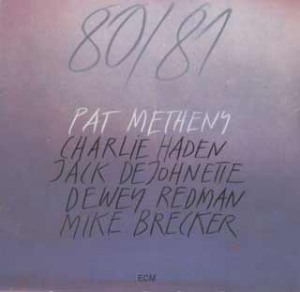
Why I Bought It: Pat Metheny’s involvement in Steve Reich’s Electric Counterpoint and Ornette Coleman’s Song X prodded me to pick up a dollar copy of 80/81, although I left behind a good percentage of his late 1970s and early 1980s releases. While I can sign off on a Metheny album with prominent involvement from Charlie Haden and Jack DeJohnette, my hesitation over his folk-jazz fusion compositions won’t go away until I actually hear one of his records, not a collaboration with a respected peer. 80/81 doesn’t quite qualify as that record, but at least most of these are his compositions.
Verdict: The first minute of “Two Folk Songs” was rather unnerving, as Metheny’s acoustic guitar drives a mid-tempo folk-jazz hybrid into disturbingly light terrain. As the song progressed, however, Jack DeJohnette pummeled away my doubts. His forceful drumming keeps side A from losing focus and pushes Metheny’s acoustic guitar to the background, at least until Metheny gains enough steam to compete. Sides B and C switch to more traditional, less folk-influenced post-bop, including a version of Ornette Coleman’s “Turnaround” from his 1959 LP Tomorrow Is the Question. Tenor saxophonists Dewey Redman and Mike Brecker steal Metheny’s thunder on the lengthy “Open,” spiraling their dueling leads upward in a cacophonous riot as Metheny’s ascending notes only serve as a distraction. Side D returns to the folk-jazz blend of side A, but DeJohnette isn’t nearly as thunderous on these comparatively laid-back tracks. “Every Day (I Thank You)” and “Goin’ Ahead” give Metheny’s layered guitar tracks center stage, but lack the energy of the previous three sides.
80/81 essentially succeeds in spite of Metheny, since the contributing players give far more spirited performances. It’s not difficult to see his approach for this record—bring in acclaimed jazz musicians, do one LP of folk-jazz fusion to demonstrate his particular take on the genre, do one LP of post-bop to lure in the purists and prove his mettle in a more traditional context. Yet 80/81 doesn’t sell me on Metheny’s own compositions when they’re highlighted in the mix (side D), so an album I largely enjoy ultimately does nothing to encourage me to check out Metheny’s personal discography.
40. Bullet Lavolta - The Gift - Taang!, 1989

Why I Bought It: Future Chavez guitarist and Joy Ride screenwriter Clay Tarver started out in the Boston-based Bullet Lavolta, so I was more than willing to grab their debut LP for a dollar. Grabbing it, sure; listening to it, no. The Gift has been lurking in my record collection since I grabbed it (along with a few Volcano Suns LPs and a few less noteworthy albums) at a record fair in Champaign.
Verdict: Whereas Chavez’s riff-driven indie rock had hints of traditional hard rock but never succumbed to the genre’s vices, Bullet Lavolta are neck deep in hard rock bluster. Whether it’s because this material hasn’t aged well, it lacks the visceral jolt of the live setting, or my taste for throttling hard rock doesn’t meet the dosage, The Gift simply doesn’t hit squarely. Tarver and Ken Chambers attempt to find the midpoint between the breakneck pace of 1980s hardcore and the righteous shredding of early Van Halen on tracks like “X Fire,” “Sneer,” “The Gift,” and “Trapdoor,” but never sound as inspired as their source material. Vocalist Yukki Gipe wails and sneers on most tracks, but on “Birth of Death” tries to appropriate the guttural incantations of death metal with curious results, not exactly the intended effect. A reviewer on Amazon writes that if Bullet Lavolta existed in 1994 instead of 1989, they would have been a huge act in the midst of the alternative revolution, but I’ll take that prompt a different way. If Bullet Lavolta existed in 1994 instead of 1989, the weaker tendencies in their sound—the hard rock bluster, in short—would have been antithetical to the times and they likely would have been a more appealing band. Thankfully, Chavez’s mid 1990s existence saves me from worrying too much about Clay Tarver’s squandered potential.
|
|
I finally finished loading up my iPod for the second round of iPod Chicanery. This time there are 1251 songs lasting for 3.4 days. I’ve used the forethought this time of creating a “Continuing Random” playlist at the start that I’ll keep paring down as I update the project (which should be around every 100 songs).
So what ended up on the playlist this time? Part of me thinks it’ll be better to reveal the contents as they come up, but I’ll divulge a few of the picks now. I did a fair amount of research into which records I’ve inexplicably missed, which records fulfill genre holes in my listening habits, and which records will mix up the flow nicely, so those choices will probably be the ones that immediately come to mind.
Most Likely to Cause Car Accident: I decided to include Stars of the Lid’s And Their Refinement of the Decline—all two hours of it—since it nicely bridges the gap between ambient and minimalist classical. The examples of those genres that I included for the last round, Eluvium and Philip Glass respectively, often made me relax during morning commutes, so hopefully that will be the result again, not fiery death.
Lungfish Selections: I’ve slowly been making my way through Lungfish’s impressive catalog and opted to include three releases that I’m only vaguely familiar with for this round: Artificial Horizon, Pass and Stow, and Necrophones. I can’t think of any other artist who eked three albums onto the iPod, but Lungfish displayed remarkable consistency with the picks of Rainbows from Atoms, Indivisible, and The Unanimous Hour for the last round.
Taking Cues: I ended up stealing ideas for jazz records to include from Floodwatchmusic, namely Miles Davis’s live album Agharta, Bobby Hutcherson’s Components (since Montara was not easy to track down), and John Coltrane’s Meditations. These are joined by Herbie Hancock’s Thrust, which I had picked up on vinyl a few weeks ago, and Ornette Coleman’s The Shape of Jazz to Come.
New Releases: I didn’t want this round to be all 2007 releases, but the new Battles, Narrator, Shannon Wright, 65daysofstatic, Twilight Sad, Pelican, Mary Timony Band, Caspian, Berg Sans Nipple, Errors, and Stars of the Lid albums all made it onto the playlist. My apologies to Wilco, Nina Nastasia, the Arcade Fire, Jesu, and Trans Am records and any other amazing records that manage to leak in the next three months. I’ll have to listen to you on my laptop.
Album I’m Most Excited to Hear: Since getting into Philip Glass’s minimal work, I’ve been trying to track down other solid releases in this vein, and Steve Reich’s Music for 18 Musicians came up as the dominant example. I initially downloaded the 1978 ECM version, which was only one track and 56 minutes long. Well, as much as I like a challenge, I gladly opted for the more recent Nonesuch recording, which is longer, but is also broken up into more manageable sections. I’ve been absorbed by this album since downloading it, so I’m quite eager to hear how it mixes with the other material on the playlist.
Those are all the spoilers you’re getting for now. I haven’t even divulged which eight rap albums made it on—only five are Wu-Tang Clan related!
|
|

